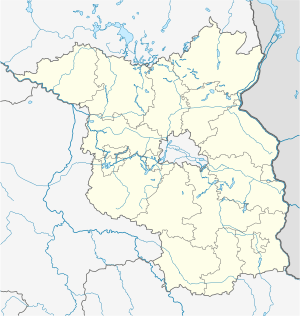Lunow-Stolzenhagen
Lunow-Stolzenhagen is a municipality in the district of Barnim in Brandenburg in Germany.
Lunow-Stolzenhagen | |
|---|---|
Location of Lunow-Stolzenhagen within Barnim district  | |
 Lunow-Stolzenhagen  Lunow-Stolzenhagen | |
| Coordinates: 52°56′00″N 14°06′30″E | |
| Country | Germany |
| State | Brandenburg |
| District | Barnim |
| Municipal assoc. | Britz-Chorin-Oderberg |
| Subdivisions | 2 Ortsteile |
| Government | |
| • Mayor | Andrea von Cysewski-Anders (WG) |
| Area | |
| • Total | 33.69 km2 (13.01 sq mi) |
| Elevation | 3 m (10 ft) |
| Population (2018-12-31)[1] | |
| • Total | 1,216 |
| • Density | 36/km2 (93/sq mi) |
| Time zone | CET/CEST (UTC+1/+2) |
| Postal codes | 16248 |
| Dialling codes | 033365 |
| Vehicle registration | BAR |
| Website | www.amt-oderberg.de |
Demography

Development of population since 1875 within the current boundaries (Blue line: Population; Dotted line: Comparison to population development of Brandenburg state; Grey background: Time of Nazi rule; Red background: Time of communist rule)
|
|
|
gollark: Beryllium's symbol is Be.
gollark: <:boron:674876365367017492>eans
gollark: Histograms are just... why. Did they think "we must invent the most confusing and irritating possible way to represent data" or something?
gollark: I quite like maths. Except circle theorems and histograms.
gollark: They get around the fact that common calculators can do a not insignificant amount of the maths-exam stuff automatically by having a non-calculator paper for further maths, requiring working, and having more complex multi-step questions.
References
- "Bevölkerung im Land Brandenburg nach amtsfreien Gemeinden, Ämtern und Gemeinden 31. Dezember 2018". Amt für Statistik Berlin-Brandenburg (in German). July 2019.
- Detailed data sources are to be found in the Wikimedia Commons.Population Projection Brandenburg at Wikimedia Commons
This article is issued from Wikipedia. The text is licensed under Creative Commons - Attribution - Sharealike. Additional terms may apply for the media files.